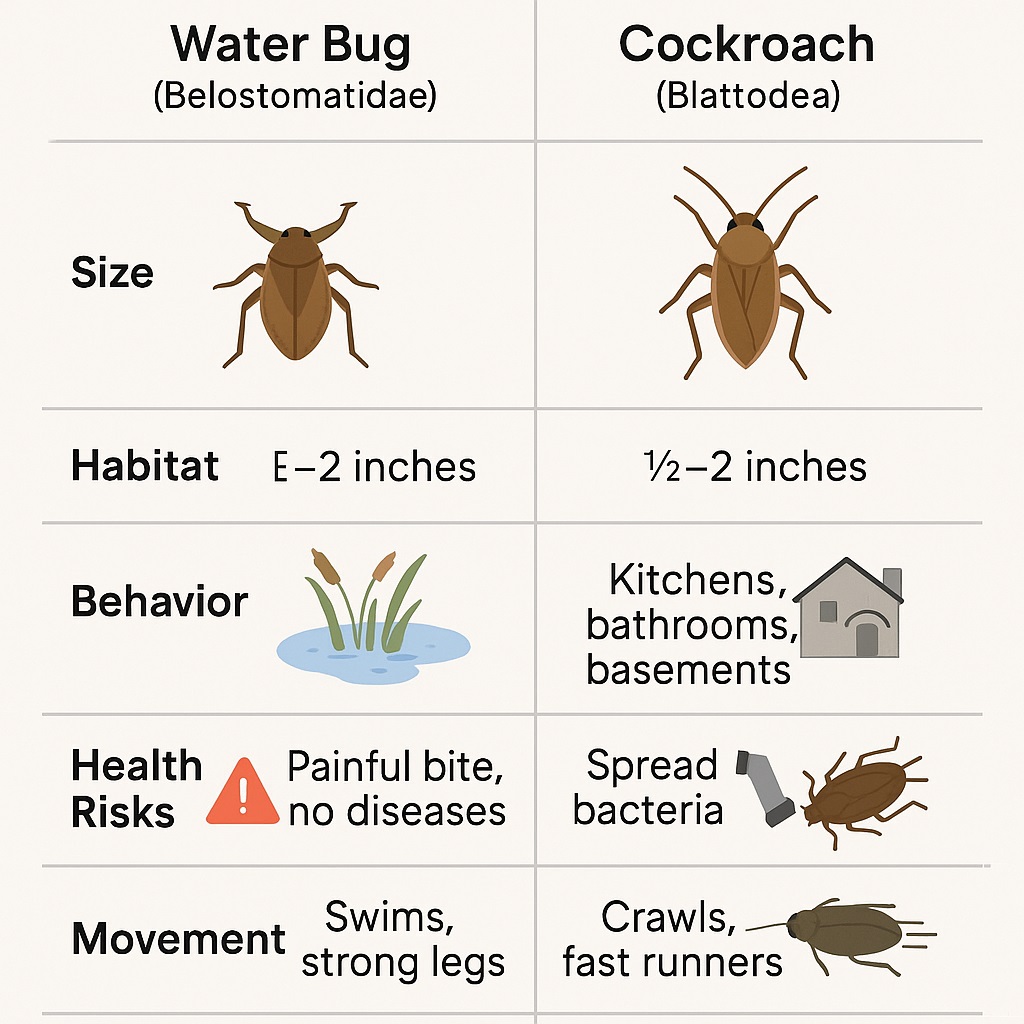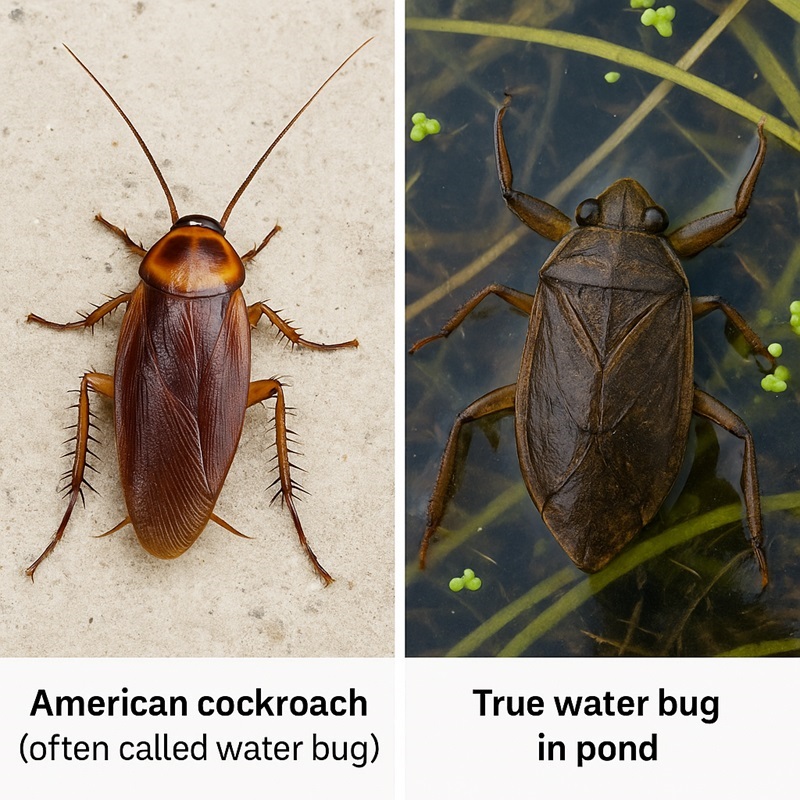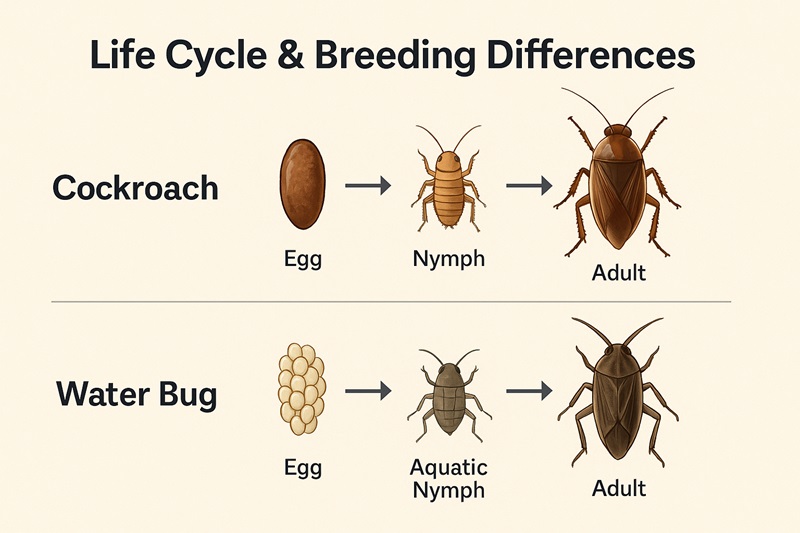Quick Answer
Water bugs and cockroaches are often confused, but they’re very different pests. Water bugs are large aquatic insects that bite if threatened, while cockroaches are land-dwelling household pests that spread bacteria and allergens. Water bugs usually wander indoors from drains or pools, while cockroaches infest kitchens, bathrooms, and basements.
At a Glance: Water Bug vs Cockroach
| Feature | Water Bug (Belostomatidae) | Cockroach (Blattodea) |
| Size | 1–2 inches (larger) | ½–2 inches |
| Habitat | Ponds, pools, drains | Kitchens, bathrooms, basements |
| Behavior | Bites when threatened, solitary | Scavengers, infest in groups |
| Health Risks | Painful bite, no diseases | Spread bacteria, trigger asthma |
| Movement | Swims, strong legs | Crawls, fast runners |
What Are Water Bugs?
Despite their misleading nickname, water bugs aren’t cockroaches at all. They belong to the insect family Belostomatidae and are true aquatic predators. Sometimes called “toe-biters,” they use their strong pincers to capture prey such as fish, tadpoles, and other insects.
Water bugs are typically dark brown, oval-shaped, and larger than cockroaches, reaching up to two inches in length. They thrive in freshwater environments like ponds, swimming pools, and storm drains. On rare occasions, they’ll fly toward porch lights at night or wander indoors through damp areas like basements or drains.
For homeowners, the main risk is their bite. While not venomous, a water bug bite can be surprisingly painful, often compared to a bee sting.
What Are Cockroaches?
Cockroaches, on the other hand, are notorious household pests. Species like the German cockroach, American cockroach, and Oriental cockroach are common across the U.S., especially in warm, humid regions.
Unlike water bugs, cockroaches are scavengers. They thrive on crumbs, grease, and food scraps, making kitchens, pantries, and bathrooms their ideal habitats. They’re usually smaller than water bugs, though the American cockroach can rival them in size.
Cockroaches are experts at hiding. They slip into cracks, behind appliances, or under sinks, coming out at night to feed. Their flattened bodies and twitching antennae make them instantly recognizable once spotted.
Water Bug vs Cockroach: How to Tell the Difference
The easiest way to distinguish between these two pests is by looking at habitat and behavior.
- Appearance: Water bugs are bulkier with noticeable pincers; cockroaches are flatter with long, sweeping antennae.
- Where you find them: If it crawls out of your sink or scurries across the kitchen floor at night, it’s probably a cockroach. If it shows up near a pool or water source, it could be a water bug.
- Movement: Water bugs swim with strong hind legs, while cockroaches dart quickly across flat surfaces.
Why People Confuse Water Bugs with Cockroaches
Many homeowners use the term “water bug” as slang for cockroaches, especially in the Southern U.S., where large American cockroaches are commonly called water bugs. This creates confusion, since true water bugs are aquatic insects that live in ponds and streams.
The overlap happens because both insects are brown, oval-shaped, and large, and both are often spotted near drains or damp areas. But the distinction matters: calling a cockroach a “water bug” may lead to underestimating the health risks of a real roach infestation.
Risks to Homeowners
The distinction matters because the risks are very different.
- Water bugs rarely infest homes in large numbers. Their primary risk is a painful bite if handled. They don’t spread disease.
- Cockroaches pose a much greater health concern. They contaminate food, spread bacteria like E. coli and Salmonella, and worsen asthma or allergy symptoms through their droppings and shed skins.
This means a cockroach infestation should always be taken seriously, while an isolated water bug is more of a nuisance than a threat.
Health Risks in Detail: Allergies, Asthma, and Contamination
Cockroaches are more than just a nuisance — they’re a genuine public health concern. According to the CDC and EPA, cockroach allergens can worsen asthma and trigger allergic reactions, especially in children. Their droppings, saliva, and shed skins circulate through household dust, becoming airborne and hard to remove.
They also spread harmful bacteria like Salmonella and E. coli, contaminating food and surfaces. Water bugs, in contrast, pose almost no health risks beyond a painful bite.
Signs of Infestation
Water Bugs:
- Typically solitary sightings.
- Found near standing water, drains, or outdoor lights.
- Rarely multiply indoors.
Cockroaches:
- Multiple sightings at night.
- Small, pepper-like droppings around cabinets and baseboards.
- Oval egg cases (oothecae).
- Musty odor in heavily infested areas.
If you notice these warning signs, you’re more likely dealing with cockroaches than water bugs.
Water Bug vs Cockroach: Seasonal Infestation Patterns
Both water bugs and cockroaches are influenced by temperature and moisture, but their seasonal activity looks different. Understanding these patterns helps homeowners know what to expect and when to take extra precautions.
- Water Bugs
Water bugs are most active in late spring through early fall, when warm temperatures and standing water create the perfect environment. Homeowners are more likely to see them around swimming pools, ponds, and storm drains during hot, humid months. By winter, sightings usually drop off as they retreat to outdoor water sources. - Cockroaches
Cockroaches thrive year-round but adjust their behavior with the seasons. During summer and early fall, infestations can spike as heat and humidity boost their breeding cycles. In colder months, roaches often move indoors in search of warmth, food, and moisture — making kitchens and bathrooms prime hiding spots during winter.
If you see a big brown insect in summer near water, it’s likely a water bug. If you notice activity indoors — especially in winter — you’re probably dealing with cockroaches.
Regional Hotspots in the U.S.
Infestation risks also depend on where you live:
- Cockroaches: Thrive in humid southern states like Florida, Texas, and Louisiana. Warmer weather accelerates breeding cycles. Northern states also see infestations, especially when roaches move indoors in winter.
- Water Bugs: More common near wetlands, lakes, and coastal regions. Summer and early fall are peak times, especially in states with abundant freshwater or warm climates.
This regional context helps homeowners understand why they may see more of one pest than the other.
Removal and Control Tips
DIY Solutions
- Water Bugs:
- Eliminate standing water indoors and outdoors.
- Clean drains regularly with vinegar or baking soda solutions.
- Fix plumbing leaks.
- Cockroaches:
- Store food in sealed containers.
- Clean up crumbs and grease promptly.
- Use roach baits, sticky traps, or boric acid (cautiously, away from pets and children).
When to Call Pest Control
If you keep seeing cockroaches despite DIY measures, it’s time to contact a professional. Cockroach infestations grow quickly — a single female can produce hundreds of offspring in a year. Water bugs, however, usually don’t require extermination unless they’re repeatedly entering through drains or outdoor water sources.
Professional pest control services can identify entry points, apply safe treatments, and set up prevention strategies tailored to your home.
Eco-Friendly and Natural Control Options
Many homeowners want pest control without harsh chemicals. Eco-friendly approaches can be effective for both prevention and minor infestations:
- Diatomaceous earth: A natural powder that dehydrates cockroaches.
- Essential oils: Peppermint, eucalyptus, or tea tree oils can repel roaches.
- Sticky traps: Safe monitoring tools for early detection.
- For water bugs: Focus on eliminating standing water and sealing entry points — no chemicals needed.
These methods won’t always replace professional treatments for large infestations, but they provide safer, sustainable first steps.
Recommended Read: Kissing Bug vs Stink Bug
Which Infestation Is Harder to Control?
When it comes to long-term management, cockroach infestations are much harder to control than water bug encounters. The reason lies in how these two pests live and reproduce.
- Water Bugs:
Water bugs are usually accidental intruders. They don’t breed indoors and won’t establish colonies in your home. Once you eliminate the water source that attracted them — such as a clogged drain, leaky pipe, or swimming pool — the problem typically resolves. A water bug sighting often points to a moisture issue, not a true infestation. - Cockroaches:
Cockroaches are survival experts. A single female can produce hundreds of offspring in a year, quickly turning a few roaches into a full-blown infestation. They hide deep in cracks, walls, and appliances, making them difficult to reach with surface cleaning or sprays. To make matters worse, cockroaches have developed resistance to many common pesticides, meaning DIY efforts often fall short.
While water bugs may startle homeowners, they rarely become a chronic problem. Cockroaches, however, can establish thriving colonies indoors, spread rapidly, and require persistent control efforts — often with professional pest management.
Life Cycle & Breeding Differences
The life cycles of these two insects explain why infestations behave so differently:
- Water Bugs: Females lay eggs in aquatic environments. Some species even carry eggs on the male’s back until hatching. Because they depend on water to reproduce, they rarely establish populations inside homes.
- Cockroaches: Cockroaches lay eggs in protective cases (oothecae), which hatch into dozens of nymphs. The German cockroach is especially prolific, with females producing up to 300–400 offspring annually. Once established, infestations can explode rapidly.
This reproductive difference is why a water bug encounter is usually a one-off, while cockroach problems spiral into chronic infestations.
Prevention Tips for a Pest-Free Home
Homeowners can avoid both pests by focusing on moisture and sanitation control:
- Fix leaks and reduce humidity with dehumidifiers.
- Seal cracks and crevices around doors, windows, and pipes.
- Install drain covers and check sump pumps.
- Keep kitchens spotless and garbage tightly sealed.
- Maintain outdoor areas: skim pools, reduce standing water, and trim overgrown plants.
Frequently Asked Questions
Are water bugs just big cockroaches?
No. They are entirely different species — water bugs are aquatic insects, while cockroaches are household scavengers.
Do water bugs infest homes?
Rarely. They may wander indoors but don’t reproduce inside like cockroaches.
Do cockroaches bite?
Cockroaches rarely bite humans, but they can when food is scarce. Their bigger danger lies in spreading disease.
Which is worse, a water bug or a cockroach?
For health reasons, cockroaches are far worse. Water bugs are more of a nuisance with painful bites but no disease risk.
Cost of Control: DIY vs Professional
Pest control costs vary depending on the severity and species:
- Water Bugs: Rarely require professional extermination. DIY solutions (drain cleaning, sealing leaks) usually suffice. Minimal to no cost.
- Cockroaches: Professional extermination averages $150–$400 per treatment, with recurring services often needed for severe infestations. DIY traps and sprays may help, but persistent colonies usually demand expert help.
Providing this cost perspective helps homeowners weigh whether to handle pests themselves or call in professionals.
Bottom Line
If you’ve spotted a large, brown insect in your home, knowing whether it’s a water bug or cockroach is the first step to effective control. Water bugs are outdoor wanderers with little long-term risk, while cockroaches are serious indoor pests that demand swift action. By learning how to identify them, understanding the risks, and taking proactive prevention measures, homeowners can keep their living spaces safe, clean, and pest-free.




